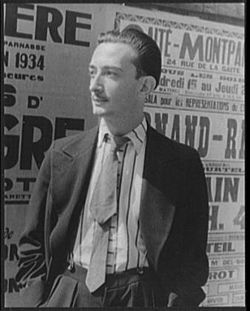|

Salvador Dalí was born on May 11, 1904, in the
town of Figueres in Catalonia, Spain, son of the comfortably off
middle-class notary Salvador Dalí i Cusí and Felipa Domenech
Ferres. Dalí's father, a lawyer who was a strict disciplinarian,
was tempered by his wife who encouraged her son's drawing. Dalí
had an older brother, also named Salvador, who died prior to
Dalí’s birth. He also had a sister Ana María who was 3 years
younger than him.
Dalí attended Municipal Drawing School, where he
first received formal art training. In 1916 Dalí discovered
modern painting on a summer vacation to Cadaqués with the family
of Ramon Pichot, a local artist who made regular trips to Paris.
The next year Dalí's father organized an
exhibition of his charcoal drawings in their family home. He had
his first public exhibition at the Municipal Theater in Figueres
in 1919. In 1921 Dalí’s mother died of cancer, when he was only
16 years old. After her death, Dalí’s father married the sister
of his deceased wife; Dalí somewhat resented this marriage.
In 1922 Dalí moved in to the "Residencia de
Estudiantes" (Students' Residence) in Madrid. Dalí already drew
attention as an eccentric, wearing long hair and sideburns,
coat, stockings and knee breeches in the fashion style of a
century earlier. But his paintings, where he experimented with
Cubism, got him the most attention from his fellow students.
Dalí was expelled from the Academy in 1926 shortly before
his final exams when he stated that no one on the faculty was
competent enough to examine him.
That same year he made his first visit to Paris,
where he met with Pablo Picasso, whom young Dalí revered; the
older artist had already heard favorable things about Dalí. Dalí
did a number of works heavily influenced by Picasso over the
next few years, as he groped towards developing his own style.
Some trends in Dalí's work that would continue throughout his
life were already evident in the 1920s, however: Dalí
omnivorously devoured influences of all styles of art he could
find and then produced works ranging from the most academic
classicism to the most cutting edge avant-garde, sometimes in
separate works, and sometimes combined. Exhibitions of his works
in Barcelona attracted much attention, and mixtures of praise
and puzzled debate from critics.
In 1929, Dalí
met his future wife, Gala,
born Helena, a Russian immigrant
eleven years his senior who was then married to the surrealist
poet Paul Eluard. In the same year, Dalí had important
professional exhibitions and officially joined the Surrealist
group in the Montparnasse quarter of Paris (although his work
had already been heavily influenced by Surrealism for 2 years).
In 1934 Dalí and Gala, having lived together
since 1929, were married in a civil ceremony. They re-married in
a Roman Catholic ceremony in 1958.
In 1936 Dalí took part in the International
Surrealist Exhibition. His lecture entitled Fantomes
paranoiaques authentiques was delivered wearing a deep-sea
diving suit.
As war started in Europe, Dalí and Gala moved to
the United States in 1940, where they lived for eight years. In
1942
he published his entertaining autobiography, The Secret Life
of Salvador Dalí.
He spent his remaining years back in his beloved
Catalonia. The fact that he chose to live in Spain while it was
ruled by Franco drew criticism from progressives and many other
artists. As such, probably at least some of the common dismissal
of Dalí's later works had more to do with politics than the
actual merits of the works themselves.
Late in his career Dalí did not confine himself
to painting but experimented with many unusual or novel media
and processes; for example, he made bulletist works and claimed
to have been the first to employ holography in an artistic
manner. Several of his works incorporate optical illusions. In
his later years, young artists like Andy Warhol proclaimed Dalí
an important influence on pop art.
In 1960 Dalí began work on the Teatre-Museu Gala
Salvador Dalí in his home town of Figueres; it was his largest
single project and the main focus of his energy through 1974. He
continued to make additions through the mid 1980s.
In 1982 King Juan Carlos of Spain bestowed on
Dalí the title Marquis of Pubol, for which Dalí later paid him
back by giving him a drawing (Head of Europa, which would
turn out to be Dalí's final drawing), after the king visited him
on his deathbed.
Gala died on June 10, 1982. After Gala's death,
Dalí lost much of his will to live. He deliberately dehydrated
himself—possibly as a suicide attempt, possibly in an attempt to
put himself into a state of suspended animation, as he had read
that some micro-organisms could do.
He moved from Figueres to the castle in Pubol
which he had bought for Gala and was the site of her death. In
1984 a fire broke out in his bedroom under unclear
circumstances—possibly a suicide attempt by Dalí, possibly a
murder attempt by a greedy caretaker, possibly simple negligence
by his staff—but in any case Dalí was rescued and returned to
Figueres where a group of his friends, patrons, and fellow
artists saw to it that he was comfortable living in his
Theater-Museum for his final years.
There have, however, been allegations that his
guardians forced Dalí to sign blank canvases that would later
(even after his death) be used and sold as originals. As a
result, art dealers tend to be wary of late works attributed to
Dalí.
Salvador Dalí died of heart failure at Figueres
on January 23, 1989, at the age of 84. He is buried in the crypt
of his Teatro Museo in Figueres.
Biography courtesy of
Wikipedia.org
[Return
to The Art of Salvador Dali]
|
